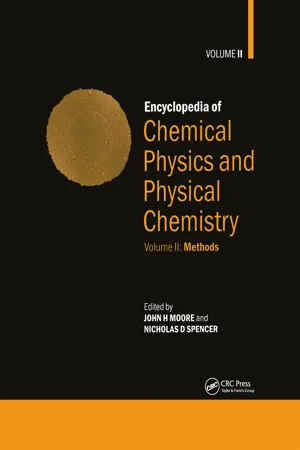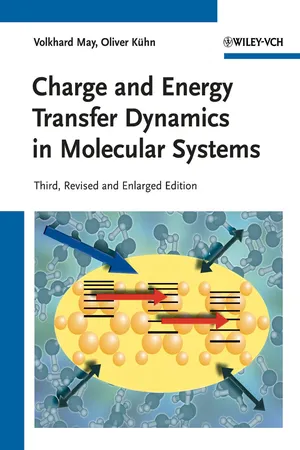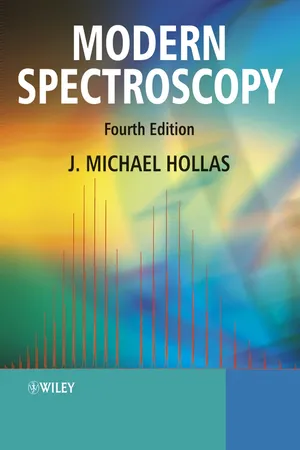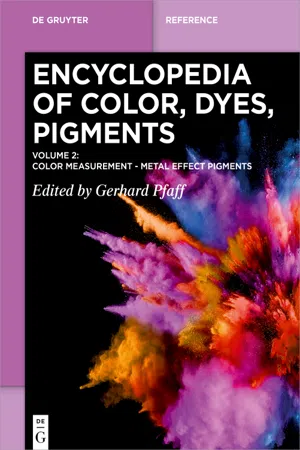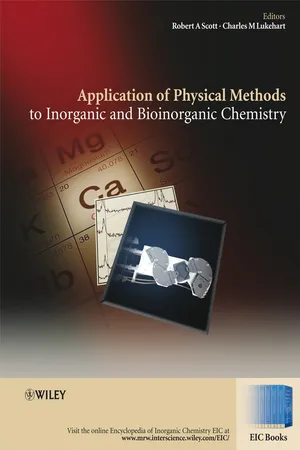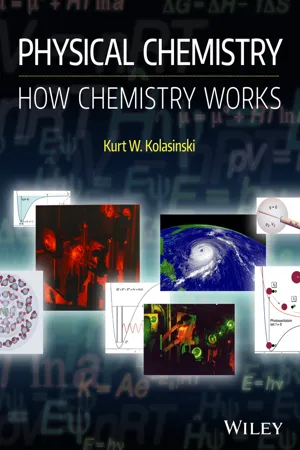Chemistry
Electronic Transitions
Electronic transitions refer to the movement of an electron from one energy level to another within an atom or molecule. This process is accompanied by the absorption or emission of electromagnetic radiation, such as visible light or ultraviolet radiation. Electronic transitions play a crucial role in understanding the behavior of atoms and molecules in chemical reactions and spectroscopy.
Written by Perlego with AI-assistance
Related key terms
11 Key excerpts on "Electronic Transitions"
- eBook - ePub
Encyclopedia of Chemical Physics and Physical Chemistry
Volume 2: Methods
- John H. Moore, Nicholas D. Spencer(Authors)
- 2023(Publication Date)
- CRC Press(Publisher)
Electronic spectroscopy S J StricklerB1.1.1 Introduction
Optical spectroscopy is the study of the absorption and emission of light by atoms, molecules, or larger assemblies. Electronic spectroscopy is the branch of the field in which the change produced by the absorption or emission is a rearrangement of the electrons in the system. These changes are interpreted in terms of the quantum theory of electronic structure. To a first approximation, the rearrangements usually correspond to an electron being transferred from one orbital to another, and a transition will be described in terms of those orbitals. The wavelengths or frequencies of transitions help identify atoms and molecules and give information about their energy levels and hence their electronic structure and bonding. Intensities of absorption or emission give information about the nature of the electronic states and help to determine concentrations of species. In the case of molecules, along with the rearrangements of electrons there are usually changes in nuclear motions, and the vibrational and rotational structure of electronic bands give valuable insights into molecular structure and properties. For all these reasons, electronic spectroscopy is one of the most useful tools in chemistry and physics.Most Electronic Transitions of interest fall into the visible and near-ultraviolet regions of the spectrum. This range of photon energies commonly corresponds to electrons being moved among valence orbitals. These orbitals are important to an understanding of bonding and structure, so are of particular interest in physical chemistry and chemical physics. For this reason, most of this chapter will concentrate on visible and near-UV spectroscopy, roughly the region between 200 and 700 nm, but there are no definite boundaries to the wavelengths of interest. Some of the valence orbitals will be so close in energy as to give spectra in the near-infrared region. Conversely, some valence transitions will be at high enough energy to lie in the vacuum ultraviolet, below about 200 nm, where air absorbs strongly and instrumentation must be evacuated to allow light to pass. In this region are also transitions of electrons to states of higher principal quantum number, known as Rydberg states. At still higher energies, in the x-ray region, are transitions of inner-shell electrons, and their spectroscopy has become an extremely useful tool, especially for studying solids and their surfaces. However, these other regions will not be covered in detail here. - D. W. H. Rankin, Norbert Mitzel, Carole Morrison(Authors)
- 2013(Publication Date)
- Wiley(Publisher)
The number of bands depends on the number of orbitals to which Electronic Transitions can occur and the selection rules governing such transitions. Selection rules are not absolute, and the ways in which they can be relaxed are responsible for much of the great variation in intensities of Electronic Transitions. The relevance of all these factors to transition-metal complexes, usually studied in solution, is described in Section 9.6. For solids and liquids, electronic absorption bands are usually broad and essentially featureless, but more information is obtainable from electronic spectra of gas-phase molecules. Transitions between two levels with long lifetimes are the most informative. Such an electronic transition for a gas-phase sample has various possible changes in vibrational and rotational quantum numbers associated with it, so that the spectrum, however it is obtained, consists of a number of vibration bands, each with rotational fine structure, together forming an electronic system of bands. The selection rules governing the changes in vibrational and rotational quantum numbers depend on the nature of the electronic transition, and they can be ascertained by analyzing the pattern and structures of the bands. One important feature of Electronic Transitions is that the Δ v = ±1 selection rule for pure vibrational transitions no longer applies. An electronic band can therefore show a progression of peaks due to Δ v = 0, 1, 2, 3... bands for one or more vibrations. This gives us a much more detailed picture of the potential well than the single Δ v = 1 pure vibrational transition. Analysis of progressions leading to dissociation (at which point the progression breaks off to be replaced by continuous absorption) can give us accurate values of dissociation energies for simple molecules. In absorption, the progression relates to the vibration levels of the upper state- eBook - ePub
- Preeti Gupta, S. S. Das, N. B. Singh(Authors)
- 2023(Publication Date)
- Jenny Stanford Publishing(Publisher)
Edited by Preeti Gupta, S. S. Das, and N. B. Singh Copyright © 2023 Jenny Stanford Publishing Pte. Ltd. ISBN 978-981-4968-32-4 (Hardcover), 978-1-003-41258-8 (eBook) www.jennystanford.com8.2 The Nature of Electronic Excitations
When continuous electromagnetic radiation passes through the transparent solution of materials, there may be the absorption of certain wavelengths of radiation. If this happens, the spectrum obtained after passing the transmitted radiation through the prism will no longer be continuous and bears some gaps in it, which is termed as absorption spectrum. As a consequence of absorption of energy (ΔE), atoms or molecules reach the higher energy excited state (Eexcited ) from the lower energy ground state (Eground ). This excitation process is quantized as shown in Figure 8.1 .Energy absorbed = Energy of excited state – Energy of ground stateFigure 8.1 Electronic excitation in molecules.(8.1)ΔE = E excited- E ground= hvThe electronic transition which occurs in UV-Vis spectroscopy is between the various electronic energy levels. Therefore, it is also termed electronic spectroscopy. Because of the absorption of energy, the probable electron transition is from the highest occupied molecular orbital (HOMO) to the lowest unoccupied molecular orbital (LUMO) of greater potential energy. The ΔE value for most of the molecular systems is ranging from 125 to 650 kJ/mole.For most of the molecular systems, the occupied orbitals are denoted by σ, π, and n which possess electron pairs of σ and π bonds and non-bonded pairs of electrons, respectively. The unoccupied orbitals mostly referred to as antibonding orbitals (σ* and π*) are of the highest potential energy. The promotion of an electron from a π-bonding orbital to a π* antibonding orbital is designated as π → π*. The n → π* transition requires less energy compared π → π* or σ → σ* transition. As n-electrons do not form bonds, there are no antibonding orbitals associated with them. There are four important types of transition: (a) σ → σ* (b) n → σ* (c) π → π* (d) n → π* (Figure 8.2 - Volkhard May, Oliver Kühn(Authors)
- 2011(Publication Date)
- Wiley-VCH(Publisher)
n =1,2,…). We expect many similarities between externally induced Electronic Transitions and those induced by internal perturbations. In particular, this holds when the coupling is weak, which allows for a perturbational treatment. Such a situation is the main reason to discuss the theoretical description of optical absorption in some detail. Many of the relations we introduce here will be valid also for other types of transfer processes treated to be in the following chapters.6.1.1Optical TransitionsWe start with some qualitative considerations of optical absorption. Details on the theoretical background of molecule radiation field interaction have been already presented in Chapter 4. Let us focus on a simple diatomic molecule. The ground state shall be characterized by the PES U g (R ), whereas the excited state PES is given by U e (R ). R denotes the relative distance between the two atoms, and rotational motion will be neglected. Both PESs are assumed to have a single minimum at R a (a = g , e ). Usually, R e >R g , since an electronic excitation results in a weakening of the bond. The electronic transition can be considered to take place on a time scale that is fast compared to the relative motion of both nuclei (bond vibration).63) We can disregard the nuclear motion during the time of the electronic transition (conservation of nuclear momenta). In the picture of PES this means that the electronic transition is vertical and the nuclei are frozen during the transition as shown in Figure 6.1 . This scheme for optical transitions in molecules is known as the Franck–Condon principle .Figure 6.1 Ground and excited state PESs of a diatomic molecule versus bond distance R . Different vertical transitions are shown that correspond to different relative positions in the sense of classical physics.Next, we discuss how this principle can affect the details of absorption spectra. We start with a classical description of the relative motion of the two nuclei. Although the nuclear motion in molecules is of quantum nature, the classical description is correct if the energy of a characteristic vibrational quantum is much smaller than a characteristic mean energy of the vibrational motion, for example, smaller than the thermal energy k B T- eBook - ePub
- Jeanne L. McHale(Author)
- 2017(Publication Date)
- CRC Press(Publisher)
11 Electronic spectroscopy 11.1 Introduction Because electronic energy levels are more widely spaced than vibrational and rotational levels, the study of electronic spectroscopy encompasses many of the previously discussed concepts concerning rotational and vibrational spectra. In electronic spectra of gas-phase molecules, analysis of rovibrational transitions within an electronic absorption or emission band can provide useful structural information, particularly when the pure rotational or vibrational spectrum is forbidden. In condensed phases, discrete rotational structure is not observed, but vibrational transitions contributing to the linewidth are often resolved. For example, the electronic absorption spectrum of benzene, shown in Figure 11.1, displays vibrational structure which will be analyzed in Section 11.5.3. In larger molecules, the high density of vibrational states serves to blur the vibrational structure. In solution, the line-broadening influence of the solvent may prevent individual vibronic transitions from being resolved, but they contribute to the linewidth nonetheless. Consider the absorption spectra of I 2, shown in Figure 11.2. In the vapor phase, vibrational transitions are resolved as separate peaks. In solution, however, the vibrational transitions of I 2 continue to contribute to the breadth of the spectrum, but are not resolved as distinct features. In this chapter, we will concentrate on the analysis of vibrational contributions to electronic spectra. These hold the key to determining the difference in equilibrium geometries of the ground and excited electronic states - eBook - ePub
- J. Michael Hollas(Author)
- 2013(Publication Date)
- Wiley(Publisher)
v ″, respectively. We shall be discussing absorption as well as emission processes and it will be assumed, unless otherwise stated, that the lower state is the ground state.In electronic spectra there is no restriction on the values that Δv can take but, as we shall see in Section 7.2.5.3, the Franck–Condon principle imposes limitations on the intensities of the transitions.Vibrational transitions accompanying an electronic transition are referred to as vibronic transitions. These vibronic transitions, with their accompanying rotational or, strictly, rovibronic transitions, give rise to bands in the spectrum, and the set of bands associated with a single electronic transition is called an electronic band system. This terminology is usually adhered to in high-resolution electronic spectroscopy but, in low-resolution work, particularly in the liquid phase, vibrational structure may not be resolved and the whole band system is often referred to as an electronic band.Vibronic transitions may be divided conveniently into progressions and sequences. A progression, as Figure 7.18 shows, involves a series of vibronic transitions with a common lower or upper level. For example, the v ″ = 0 progression members all have the v ″ = 0 level in common.Figure 7.18Vibrational progressions and sequences in the electronic spectrum of a diatomic moleculeQuite apart from the necessity for Franck–Condon intensities of vibronic transitions to be appreciable, it is essential for the initial state of a transition to be sufficiently highly populated for a transition to be observed. Under equilibrium conditions the population of any v ″ level is related to that of the v - eBook - ePub
- Gerhard Pfaff(Author)
- 2022(Publication Date)
- De Gruyter(Publisher)
26 ], to which readers are referred for deeper insight.31.3 Calculation of the electronic transition energy of molecules
As mentioned, electronic spectra arise from transition between electronic states and are accompanied by simultaneous transitions between electronic and vibrational states (neglecting rotational states as done by Condon). To consider all vibrational states would make the calculations very complicated.At room temperature the ground vibrational state of the ground electronic state (v00 = 0) is mostly populated, whereas the first excited vibrational state (v01 = 1) at 298 K is populated to N1 = N0 ·0.001 only [11 , 18 ]. Therefore, at room temperature it is a well-founded approximation to assume the main part of absorption bands arise from transitions between the lowest vibrational state of n = 0 and different vibrational states of n = 1 termed 0–0, 0–1, 0–2 … vibronic transitions.With this approximation the transition energy of the vibronic transitions ΔE00, 1v is the difference between the minimum of the electronic energy surfaceE 1(Re ) of the first electronic excited state n = 1 (S1 ) plus the considered vibrational energy h·e lν 1(v1 + ½) and the minimum of the electronic energy surfacev iE 0(Re ) of the electronic ground state n = 0 (S0 ) plus the ZPVE (½ h·e lν 0):v i(31.9)ΔE=00 , 1 vE 1(e lR e) + h ⋅ν 1(v iv 1+1 2) − [E 0( R e ) +e l1 2h ⋅ν 0]v iThese are the only calculated values, which are related to experimental values, the energies of the 0–v vibronic transitions [10 , 11 ].For the special case that the transition occurs between the two vibrational ground states, eq. (31.9 - Robert A. Scott, Charles M. Lukehart(Authors)
- 2013(Publication Date)
- Wiley-Interscience(Publisher)
3 This result shows that the energy of any eigenstate is exactly that which one would calculate by an electrostatic calculation of Coulombic interactions of the charge cloud and the nuclei. The charge cloud is defined by the square of the electronic wavefunction. Each electronic state is described by its individual wavefunction and subsequent charge cloud. Excited states will in general involve a more spatially extended charge cloud than the ground state. Furthermore, for a transition to have optical intensity the two states involved must have opposite parity. Excited states are generally more electrically dipolar than the ground state. This dipole is the “handle” by which the light field grabs the molecule and mixes ground and excited states.The independent electron approximation is central in the description of chemistry. Solutions to one-electron atomic or molecular Hamiltonians are taken as a starting point in developing the description of many-electron systems. Within this approximation, electronic excitations can be described as a particular electron jumping from one orbital to another. This approach, though useful, has no ultimate fundamental basis and fails in some situations. Additionally, in systems for which the electronic wavefunction itself is strongly dependent on the nuclear coordinate, such as Jahn–Teller active systems10 and vibronically active mixed valence systems,11 or the bacterial reaction center cation,12 ,13the Born–Oppenheimer approximation fails. In this situation some phenomena can become quite counterintuitive, such as the temperature dependence of the localization of charge.11 More fundamentally precise methods14 need to be invoked in dealing with these interesting systems.Electronic excitations can be usefully classified as one-center excitations and those involving two or more centers. Intraconfigurational transitions such as d – d and f – f- eBook - ePub
Molecules and Radiation
An Introduction to Modern Molecular Spectroscopy. Second Edition
- Jeffrey I. Steinfeld(Author)
- 2012(Publication Date)
- Dover Publications(Publisher)
5Electronic Spectra of Diatomic Molecules
1 “Ro-vibronic” Energy Levels
A transition between two different electronic states of a diatomic molecule generally involves simultaneous changes in vibrational energy and rotational energy. From the analysis of such transitions, the equilibrium internuclear distances and dissociation energies of the excited molecular states can be determined. In this chapter, we shall see how such an analysis may be carry out.For each molecular state, the spectroscopic term value contains electronic, vibrational, and rotational contributions:T e + G υ + F υ (J ).The electronic term T e measures the energy of the minimum of the potential curve for a particular state above the minimum of the ground-state curve; for the ground state itself, of course, T e = 0. The vibrational terms G υ are given by expressions of the type of equation (4.11); the exact form of the rotational terms F υ (J ) depends on the electronic quantum numbers of the particular state, and will be discussed in more detail in section 5. The actual spectrum consists of a large number of lines, grouped into vibrational bands, with frequency given by(5.1)where the single prime refers to the upper state and the double prime, to the lower state; thus = 0 if the lower state is the ground state. We shall first consider the overall vibrational structure of the transition, as may be seen with a low-resolution spectrometer, and then go on to consider the rotational fine structure of the bands.2 The Franck-Condon Principle
The first question we wish to consider is which vibrational levels are to be coupled in an electronic transition. In an infrared vibrational transition within a single electronic state, we had a fairly strict selection rule, Δυ = ± 1, even for anharmonic potentials. This arose because the matrix elements of R — R e were nonvanishing only along the diagonals just above and below the main diagonal, with very small terms elsewhere in the 〈υ |R — Re |υ’ - eBook - ePub
Characterization of Solid Materials and Heterogeneous Catalysts
From Structure to Surface Reactivity
- Michel Che, Jacques C. Vedrine(Authors)
- 2012(Publication Date)
- Wiley-VCH(Publisher)
S (~20), bands are broad and the shape becomes Gaussian-like [45]. The band width increases with increasing temperature.Electronic Transitions can also occur in the ligands, and are referred to as ligand-centered (LC) transitions. Their energies can be derived through evaluating the changes of the atomic or molecular orbitals of the ligand upon formation of the complex compound.Electronic Transitions become also possible between the central ion and its neighbors and are referred to as ligand-to-metal charge transfer (LMCT) or metal-to-ligand charge transfer (MLCT) transitions. With respect to metal cations, which are often present in solid catalysts, it should be mentioned that LMCT bands shift to lower energies and become more intense as the oxidation state increases and electron transfer become more facile. Electrons can also be transferred to the next-nearest neighbor, typically another metal cation, in a so-called intervalence charge transfer (IVCT), which can occur between like ions or between unlike ions (referred to as homonuclear and heteronuclear IVCT). IVCT bands have been found to undergo a shift towards lower energies with increasing temperature [46]. Charge transfer bands tend to be intense and broad.3.2.4 Transitions in Extended Solid Structures
3.2.4.1 Bandgaps
Bulk solids are characterized by energy bands rather than discrete states. Population of these bands can be forbidden or allowed, and the allowed states can be fully or partially occupied with electrons. Metals, metalloids, semiconductors, and insulators are defined by the population of electrons in these bands and the size of the gap between allowed states. From the perspective of UV–vis spectroscopy, semiconductors are most interesting because excitation from occupied to unoccupied levels can be effected by UV–vis radiation. - eBook - ePub
Physical Chemistry
How Chemistry Works
- Kurt W. Kolasinski(Author)
- 2016(Publication Date)
- Wiley(Publisher)
n. The energies of transitions between these high-lying energy levels can be found at lower energies in the infrared, or below.As Z increases, the binding of the K shell electrons rapidly increases. In multi-electron atoms we distinguish between core electrons and valence electrons. Core electrons are little influenced by the chemical environment and are not directly involved in bonding. They lie at very low energies and their ionization energies correspond to the vacuum ultraviolet or X-ray regions. Valence electrons are found in the highest energy normally occupied electronic states. Their ionization energies are lower than those of core electrons. Valence electrons participate in bonding. Because they are strongly linked to bonding, the energetic position of valence electron states shift sensitively in response to the chemical environment around an atom.The shifts in energy of electronic levels is detected by performing spectroscopy of various sorts. There is a great deal of spectroscopic terminology that you need to familiarize yourself with. A number of conventions surround the use of the words ‘red’ and ‘blue’ and the use of energy scales. It is conventional in many settings to place the origin of wavelength on the left. But the wavelength is inversely proportional to photon energy, which means that the origin of photon energy, frequency and wavenumber is often placed on the right. The red side of the visible spectrum is the long-wavelength/low-energy side. The blue end of the visible spectrum is the short-wavelength/high-energy side. Spectroscopists will often speak of the ‘blue end’ or ‘red end’ of a spectrum or of a ‘blue shift’ or ‘red shift’ of peaks. This terminology is used even when referring to other parts of the electromagnetic spectrum. A blue shift is a shift to higher energy, while a red shift is a shift to lower energy. Thus, we say that the a peak in the X-ray photoemission spectrum of the Ti 2P3/2 level is blue shifted from 453.8 eV in Ti metal to 458.5 eV in TiO2 , which means that the peak lies at higher energy in TiO2
Index pages curate the most relevant extracts from our library of academic textbooks. They’ve been created using an in-house natural language model (NLM), each adding context and meaning to key research topics.
